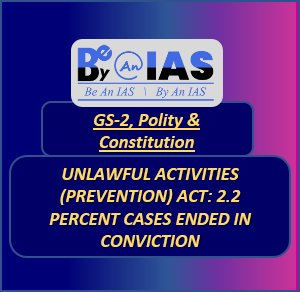CURRENT AFFAIRS
Get the most updated and recent current affair content on Padhaikaro.com
UNLAWFUL ACTIVITIES (PREVENTION) ACT: 2.2 PERCENT CASES ENDED IN CONVICTION
- Be N By IAS, Delhi
- 10, Feb 2021

For: GS-2: Polity and Constitution
CONTEXT:
- Only 2.2 % of cases registered under the Unlawful Activities (Prevention) Act between the years 2016 and 2019 ended in convictions by court as said by Home Ministry in the Rajya Sabha.
NEWS IN DETAILS:
- Total No. of Persons arrested: As per the 2019 Crime in India Report compiled by the National Crime Records Bureau, the total number of persons arrested under the Act in 2019 is 1,948.
- Arrest v. Conviction: “Further, the total number of the persons arrested and the persons convicted in the years from 2016 to 2019 under the UAPA in the country are 5,922 and 132, respectively.
- No data segregation: The NCRB does not maintain this data on the basis of religion, race, caste or gender,” the Minister stated.
- Sedition case: In the year 2019, as many as 96 persons were arrested for sedition (Section 194A IPC).
- But only two were convicted and
- 29 persons were acquitted.
- Charge sheet was filed in 40 cases the same year.

UNLAWFUL ACTIVITIES (PREVENTION) ACT:
- Aim: Effective prevention of unlawful activities associations in India.
- Unlawful activity: Action by an individual or association intended to disrupt the territorial integrity and sovereignty of India.
- Highest punishments: Death penalty and life imprisonment
- Under UAPA, both Indian and foreign nationals can be charged.
- 2004 amendment: It added “terrorist act" to the list of offences.
- 2019 Amendment: Can designate individuals as terrorists.

Source: The Hindu
MCQs:
Q. Consider the following statements.
- Under Unlawful Activities (Prevention) Act, an individual can not be designated as terrorist.
- Both Indian and foreign nationals can be charged under this act.
Which of the above statements is/are correct?
- a) 1 Only
- b) 2 Only
- c) Both 1 and 2
- d) None of the above
ANS: B